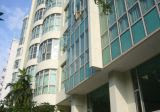More plans to build homes, higher stock prices and fewer people filing first-time claims for jobless aid sent a private-sector forecast of U.S. economic activity higher than expected in June.
It was the third straight monthly increase for the New York-based Conference Board's index of leading economic indicators, and another sign pointing toward the recession ending later this year.
The index rose 0.7 percent last month. Wall Street analysts polled by Thomson Reuters expected a gain of 0.4 percent. May's reading was revised up to a gain of 1.3 percent from 1.2 percent, while April was scaled back to 1 percent growth from 1.1 percent.
The group also said activity in the six-month period through June rose 2 percent, with an annual growth rate of 4.1 percent. That's the strongest rate since the first quarter of 2006.
The index is meant to project economic activity in the next three to six months.
If these conditions continue, "expect a slow recovery this autumn," said Conference Board economist Ken Goldstein.
The Conference Board's leading indicators index bottomed in March after peaking in July 2007. The decline accelerated last fall after investment bank Lehman Brothers collapsed and credit markets froze.
"We're now getting data which points to stabilization," said Josh Shapiro, chief U.S. economist at research firm MFR Inc. "The overall signal they're sending is the slide in economic activity is poised to end. The jury is still very much out in terms of what happens after that."
Many analysts expect modest economic growth in the fourth quarter after the gross domestic product posted the worst six-month performance in about 50 years at the end of 2008 and beginning of this year.
Stocks rose modestly on Wall Street. The Dow Jones industrial average added about 40 points in midday trading, and broader indices also edged up.
Seven of the Conference Board index's 10 indicators rose in June, including building permits, stock prices, manufacturers' new orders for consumer goods and positive readings on jobs. Consumer expectations, manufacturers' orders for capital goods and the real money supply weighed down the forecast.
The biggest gainer was the "interest rate spread." That's the difference between yields on 10-year Treasurys and the federal funds rate, at which banks lend to one another, which is at a record low near zero. A big difference between the two is viewed as positive because investors are willing to lend for longer periods.
A government report last week showed construction of new U.S. homes in June rose to the highest level in seven months. That was the "most positive housing report in ages," said IHS Global Insight economist Patrick Newport.
The slump in housing led the country into the longest recession since World War II. The downturn has pushed the unemployment rate to a 26-year high of 9.5 percent. The Federal Reserve expects joblessness to surpass 10 percent this year and to stay above healthy levels for years.
Mass layoffs continue across many sectors, but the pace and depth of job cuts have slowed.
Subscribe to:
Post Comments (Atom)



No comments:
Post a Comment